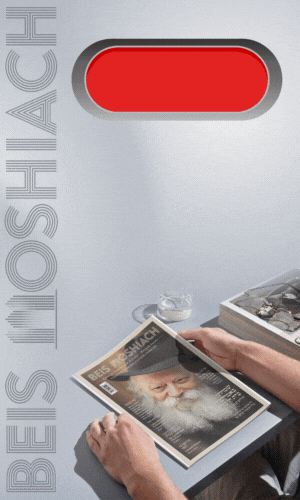Hei Teves: The Rebbe’s Nesius, Ratified
Rabbi Reuven Matusof sat down to farbreng with Beis Moshiach’s Menachem Ziegelbaum for a lively Hei Teves Farbrengen that went far beyond the book fairs: “The Rebbe’s Nesius was ratified. That meant that the Moshiach phase got a green light.” • By Beis Moshiach Magazine • Full Article
Menachem Ziegelbaum, Beis Moshiach
15 tammuz [2021] marked 36 years since the sicha in which the Rebbe said, “G-d forbid to say that since so-and-so many years have passed, therefore there has been some change or difference; on the contrary, every year the connection of each one of us to Nasi Doreinu, the Baal HaGeula, increases. Every year, especially when the Yom HaGeula comes along, we resolve to work with greater passion on his enactments and his teachings and carrying out his mission. As a result, it becomes even stronger, even relative to the degree of ‘his children are alive’ that was in the previous year, at which point it was already the case that ‘he is alive,’ so that he becomes even more alive literally here, and more ‘shturemdig’ literally here. Consequently, this also connects to his sefarim, his writings and all his possessions …
“On the contrary, when 35 years pass, G-d forbid to say they are 35 years that no longer exist. It’s the complete opposite; it’s an utter falsehood! The opposite is the truth and ‘the ultimate truth,’ that it is already 35 years that each and every year he becomes more alive, stronger, more active among us and within us and through us – in every Jew and all Jews, the entire world!”
These words of the Rebbe that were said so forcefully and with endless passion, still echo in our ears. Thirty-five years! We need to remember, “He becomes more alive literally here, and more ‘shturemdig’ literally here!”
In 5745, we all knew that the Rebbe was leading with strength and power as we saw with our own eyes. We had no question, no doubt about it. Now, however, when it has been decades since we’ve seen the Rebbe, and doubts could arise, G-d forbid, it is important to return to and reiterate in our hearts and minds this message of the Rebbe.
The entire sicha, starting with “he is alive” in the most literal sense, pertains to us today, and this was the introduction and foundation for everything that followed until Didon Notzach.
This point of “he is alive” pertains to us and we need to repeat and remember it today, Hei Teves 5782!
REMEMBERING AND RELIVING
Rabbi Reuven Matusof remembers quite clearly the “Didon Notzach” days of 5747:
It was early evening when the phone in the Lishka ran. On the line was my friend, R’ Moshe Notik. “Didon Notzach!” he exclaimed.
I immediately took out a bottle of mashke and said l’chaim. Then I thought, now what? I left the office for the yeshiva [Tomchei Tmimim of Brunoy] to celebrate and farbreng with the bachurim and talmidim-shluchim and my childhood friend from Morocco, R’ Hirshel Raskin, with whom I’d been in touch constantly from the beginning of the entire saga.
More of Anash showed up at the yeshiva including Rabbi Hillel Pevsner who also felt that it wasn’t appropriate to remain at home at such a festive, joyous time.
During the farbrengen we spoke about it being the perfect time to go to the Rebbe. R’ Pevsner felt uncomfortable. To him it was out of the question that because of this we would jump on a plane and go to the Rebbe. It sounded wild to him. True, Didon Notzach, but… there were those who said such a simcha needed to be celebrated with the Rebbe.
The next morning I got on a plane with some fellow shluchim and I had the zechus of spending those joyous days in 770. (R’ Pevsner joined us later). Those were especially joyous, uplifting days. Every night they danced and farbrenged until the wee hours, with all the mashpiim, the chozer, members of the vaad of Aguch, and others.
Sichos were said every day of that week and on the following Shabbos, parshas Vayigash 5747, the Rebbe farbrenged.
Usually, at the Rebbe’s Shabbos farbrengens, there were benches where the balabatim of Crown Heights sat. Around them stood the yungeleit and bachurim. Everyone tried to stand as close as possible in order to hear the Rebbe but this time, because of the many rabbanim and guests who came, benches were added to the Beis Medrash and we had to stand further away. It was very hard to hear everything that was said at the farbrengen.
At this farbrengen, the Rebbe spoke about “the walls of our house are cedar” – when the Rebbe spoke about the level of Yosef in whose section the Mishkan was made of cedar wood, while Yehuda had the Mikdash, a stone structure that was permanent. The Rebbe said, or more accurately announced, “We are entering a new era of stand at the ready all of you for the building of the third Beis HaMikdash.”
Although it was difficult to follow the farbrengen, this line was heard by all: I-m-d-u H-a-c-h-e-n K-u-l-c-h-e-m l’binyan Beis HaMikdash HaShelishi!
We felt that within the seventh generation a new era was commencing with the prophet standing there and announcing it.
A year after Didon Notzach, in 5748, the Rebbe used the phrase, “Didon d’ha’sefarim notzach” a few times. A few times the Rebbe said, “Didon d’ha’Rebbe Nasi Doreinu notzach.” What does this mean and to whom does the victory pertain – to the Rebbe or the sefarim?
The first year, the Rebbe spoke mainly about the kitrug (heavenly accusation) which to a certain extent was aimed at the nesius. The Rebbe compared it to the kitrug against the Alter Rebbe. In the sicha that was said on the actual day that the news came out, Hei Teves, the Rebbe mentioned the verse, “and the spirit of Yaakov their father lived,” “od Yosef chai.” These were phrases in a more personal vein from which we understood that the Rebbe was speaking about a kitrug against him and as a result of the victory, there was continuity of the nesius.
(I remember that R’ Yoel Kahan said at one of the farbrengens at that time, “The kitrug against the Alter Rebbe was on Chassidus and on Hei Teves the kitrug was on the Rebbe himself.”)
At this point, the Rebbe spoke less about the sefarim and more about the nesius as is related at length in the kuntreisim, dairies, and responses from the Rebbe at that time.
It was the following year that the Rebbe spoke about “Didon d’ha’Sefarim Notzach,” and expanded on the victory of the sefarim and noted that in every house and every room, including children’s rooms, there should be sefarim. In 5752, the Rebbe said this brings the Geula and thereby we redeem the sefarim that are still in captivity and the Jewish people as a whole.
Is Hei Teves then more the Rebbe’s holiday or a holiday of the sefarim?
It’s not a contradiction; Rebbe and sefarim are one thing.
Meaning?
The Rebbe says that if you want to live with Moshiach, what should you do? Learn inyanei Moshiach and Geula as they appear in Torah. The same is true here. You want to live with the Rebbe? Learn what he taught. Hiskashrus is through learning the Torah teachings of whoever you want to connect with. It’s not enough to be connected with an inner feeling; you need to learn the Rebbe’s teachings whether in Likutei Sichos or a maamar or a letter.
Note, right after the seven days of rejoicing of Hei Teves, after dancing day and night, the Rebbe changed direction and said that the “Didon Notzach” had to be expressed in Torah study. The Rebbe that since we were thirty days before the holiday (referring to Yud Shevat), every ten days there had to be tests administered in Nigleh and Chassidus by the roshei yeshiva.
The dancing stopped immediately and the following month, hundreds of yeshiva bachurim, balabatim and shluchim around the world sat and learned, and showed up at sedarim on time.
We saw this again on 2 Kislev 5748. That morning, the sefarim returned to the Rebbe’s library. There were people standing outside, excited by this historic event. Suddenly the Rebbe appeared and saw this and began castigating the bachurim and telling them to get inside immediately and learn because this is the real Didon Notzach.
From this we understand that taking just one thing, either the Rebbe or the sefarim, is incorrect. The Rebbe connects the two. Rebbe means learning his teachings and by learning his teachings one “grasps” the Rebbe. You can’t have one without the other.
THE THRILLING PROCLAMATION
One of the stories that is told a lot in connection with Hei Teves is about the Rebbetzin’s testimony that “my father [the Rebbe Rayatz] and the sefarim belong to the Chassidim.” The Rebbe referred to this as the decisive claim which made a tremendous impression on the judge.
What does that mean that the Rebbe belongs to the Chassidim? This is not a simple statement at all.
First, in the sicha that was said on motzoei Shabbos parshas Termua 5748, a few weeks after the passing of Rebbetzin Chaya Mushka, the Rebbe mentioned it and said that this statement expressed the eternality of the Nasi HaDor.
It’s a line that demands greater contemplation and understanding on our part since, as you noted, this was a lofty and powerful message, and even somewhat stunning to hear that the Rebbe belongs to us for we always knew that we belonged to the Rebbe (“we are your people and you are our king”).
On a simple level, we can say that the Rebbe gives his entire life to us. The Rebbe devotes himself to us. There is no time remaining for himself; it’s all for us. If you look at the Rebbe’s daily schedule this is clear.
The purpose of a Rebbe is to lead the Jewish people and the Rebbe plays the main and central role in all of our matters as well as matters that affect the entire world on the highest planes.
Perhaps this is what the Rebbe meant when he said on 28 Nissan 5751, “I did all I can. Now, do all that you can.” We always knew that the Rebbe does all the work, and at that time the Rebbe announced that now we also need to do something ourselves.
And as water reflects a face, our response has to be that “our entire essence (meaning: our entire existences) should be devoted to Him alone” (as quoted in the introduction to HaYom Yom). This is what is demanded of us, to devote ourselves completely to the Rebbe and his activities. In other words, the Rebbe belongs to the Chassidim and the Chassidim belong to the Rebbe!
Can you tell us about one image that comes to your mind of that fabulous week when you were at the Rebbe following Didon Notzach?
The farbrengen of Shabbos parshas Vayigash. It was something special. Picture thousands of Chassidim standing around and the Rebbe speaking and suddenly the Rebbe raising his voice, emotional, “Stand all of you at the ready for the building of the third Beis HaMikdash!” We felt that something new was happening. We were entering the era of the complete hisgalus.
Till today, when I think about it, it makes the heart tremble. It was an uplifting farbrengen and it wasn’t just I who felt this way but whoever was there.
HEI TEVES IS PART OF THE GEULA PROCESS
R’ Reuven Matusof is a well-known mashpia in France and in Europe in general. A few months after he married, he and his wife received the Rebbe’s blessing for shlichus to France and he began working in the European office of Lubavitch.
Along with his work in the Lishka, R’ Matusof spreads the wellsprings. He gives shiurim in Chassidus in the yeshiva in Brunoy, farbrengs with Anash in Paris and other places in France, and was active in arranging the live broadcasts of the Rebbe’s weekday farbrengens, as well as the satellite broadcast that showed the Rebbe’s encouraging of Yechi in 5753, an initiative he did along with Rabbi Yosef Yitzchok Pevsner, director of the Sinai schools in Paris.
From 5751, R’ Matusof began lecturing on inyanei Moshiach and Geula and was interviewed by Jewish newspapers in France about the Geula and the identity of the redeemer. In the years that followed he ran the “Beis Moshiach” center which explained the subject of Geula and Melech HaMoshiach in Paris. The center was a source of chayus and activity for everything having to do with Moshiach and Geula in France.
His farbrengens attract many tmimim and Chassidim since they are full of love and yearning for the Rebbe. The main subject he focuses on is hiskashrus to the Rebbe. He is invited to farbreng around the world, mainly before special calendar dates.
How does Hei Teves connect with our preparations for Moshiach?
Everything about Hei Teves is part of preparing the world for the Geula and the hisgalus of the Rebbe MH”M. First, look at the HaYom Yom for this date. The Rebbe says with the coming of Moshiach people will see the value of hoda’ah [i.e., acknowledgment of Hashem and belief in Him] and temimus (sincerity), the pure faith with which all [Jews] believe in Hashem and His Torah, and His mitzvos. The Rebbe adds that Melech HaMoshiach will explain the “maaseh gadol” (superior worth) of sincere, heartfelt avoda.
In addition, the whole idea of Hei Teves is the borderline between two eras. As I said, on the Shabbos following Hei Teves, the Rebbe announced a new era, meaning that the Didon Notzach led to a new era in everything associated with preparing for Moshiach.
Regarding Yud-Tes Kislev, the expression was coined “before Peterburg” and “after Peterburg,” differentiating between two eras, before and after the Alter Rebbe’s imprisonment. These eras are different in the way the teachings of the Alter Rebbe were revealed and impacted the world. The same is true for Hei Teves. You can say there was the period before Hei Teves and the era following it. On this day of Didon Notzach we moved on to a new stage.
That Shabbos Vayigash 5747, the Rebbe spoke animatedly about preparing for the Geula and he said that all that was missing was “polishing the buttons” for Moshiach. On Shabbos parshas Shemos of that year, the Rebbe said the polishing was overdone and in a sicha said on 2 Nissan 5748 the Rebbe said that the job of polishing had ended. We saw that the Rebbe began to use new language in connection with Geula.
The Rebbe acknowledged that these were “wild words” but the world is ready, and that the same applies when hearing the claim that “they eulogized” etc. the truth needs to be said, he is alive!
This year, on Hei Teves, we need to be more aware of our avoda of bringing Moshiach. Feelings are not enough; we need to “live” these things.
How do we do that?
We need to learn and farbreng; to speak about Moshiach, Geula, about our era and what the Rebbe wants of us. On Hei Teves 5747, the Rebbe said that everyone should farbreng in their area and bring what he heard and the feeling in 770 at that time to the people of his place.
Do you remember the feeling that you brought with you from 770 to France after those joyous days?
It’s hard to remember after so many years but I remember that there were opposing feelings. On the one hand, it was a week of great joy with farbrengens night after night. On the other hand, the Rebbe’s sicha about starting to learn seriously and prepare for Yud Shevat by learning etc. was a sharp and sudden turn. But today, in hindsight, it’s no contradiction. The joy, the learning and the hiskashrus to the Rebbe are all one thing.
If I want to “live” Hei Teves, what should I learn?
Learn the Rebbe’s teachings in general and especially inyanei Moshiach and Geula. The Rebbe spoke about the eternal life of the Nasi HaDor. Back then, nobody understood what this really meant. We listened to the Rebbe but continued our usual way of life.
And yet, if you look today, how young couples, many bachurim or Chassidishe girls who never saw the Rebbe (other than on video) are “living” with the Rebbe and know and feel, without doubts, that the Rebbe is alive, and they live with him and even go on shlichus with great mesirus nefesh, how is this possible?
The reason is simple. They learn the Rebbe’s teachings and live with the Rebbe and experience the Rebbe in real life. This is the way. When you do this, there are no doubts.
In all the maamarim and sichos, you see how the Rebbe is alive today, how the Rebbe is eternal and is going to redeem us.
I think that if there is someone who is afraid that as time passes he is losing his faith, he needs to look at the bachurim, cleave to them and get chayus from them. You can say that the young generation is saving the situation …
At that time, there was a kitrug on the Rebbe, on his nesius, on Lubavitch altogether. What is the significance of this and how is it relevant to our times?
The kitrug on the Rebbe is a painful point albeit an important one. The Rebbe himself said that the kitrug was that Lubavitch is not active.
When you think about it, it seems inexplicable. What does it mean that Lubavitch is not active?! Over the years, so much was built and done; shluchim went out, centers and Chabad Houses were built all over. How can this be understood?
What does the Rebbe say in response to this? The Rebbe demands that more be done. The Rebbe at that time asked that Chanuka gatherings be held everywhere, that pictures be sent that would be made into a beautiful album. If so, what was the kitrug about?
The point is they said a change was made, the seventh generation was something different, not a continuation of the previous generations. Lubavitch of the seventh generation is not the same Lubavitch, they claimed.
This claim is made today too, although worded differently. They want to restore things as they were, a Rebbe but without Moshiach, as though Lubavitch continues but without the chiddush of the goal of the seventh generation.
By their taking some of the sefarim which were the life of the Rebbe Rayatz, they wanted to demonstrate an aspect of interruption; that not all the elements of the previous generations were continuing with this generation, as though the leadership of this generation is something new.
But the six prior leaders of Chabad were overseeing a process that led to the innovation of the seventh generation, which receives from all of the previous generations. This is precisely the point today, that the entire chiddush of our generation is to reach the final goal of the revelation of Moshiach and bring the Geula. G-d forbid to think we tried and were unsuccessful or we need to try some other way and change direction, G-d forbid. We must know that even now, it all continues and our avoda continues precisely as the Rebbe outlined, that everything be directed toward one goal: preparing oneself and one’s surroundings and the entire world to welcome Moshiach and bring the Geula.
What should we do now, the eve of Hei Teves?
I will condense it into two important points. First, we need to follow the Rebbe’s hora’os and buy new sefarim and children should use their own money (especially those who received Chanuka gelt). The house should be a “house full of sefarim” which is one of the Rebbe’s holy mivtzaim.
Second, buying sefarim is not enough. Obviously, one should sit and learn them.
I’d like to end with a question. Why should you and I and our families rejoice on Hei Teves? How is this our Yom Tov?
The answer is simple. We saw how the Rebbe had great anguish. For two years the Rebbe lived with pain and anguish that defies description. When even the gentile court recognized the Rebbe’s nesius and his eternal life, thus canceling the kitrug on the Rebbe, this ought to make every Jew connected to the Rebbe, especially us Chassidim, very happy. Why? Because the Rebbe’s joy touches us.
We need to rejoice with the Rebbe’s joy and the Rebbe’s joy is our joy. This is the joy of our generation, the Rebbe’s joy of the Geula. The Rebbe won and the Rebbe wants us to learn from this victory and live with him every single day. Whoever lives with the Rebbe’s victory on this day, rejoices on this day.’
*
The magazine can be obtained in stores around Crown Heights. To purchase a subscription, please go to: bmoshiach.org
357
Join ChabadInfo's News Roundup and alerts for the HOTTEST Chabad news and updates!










































